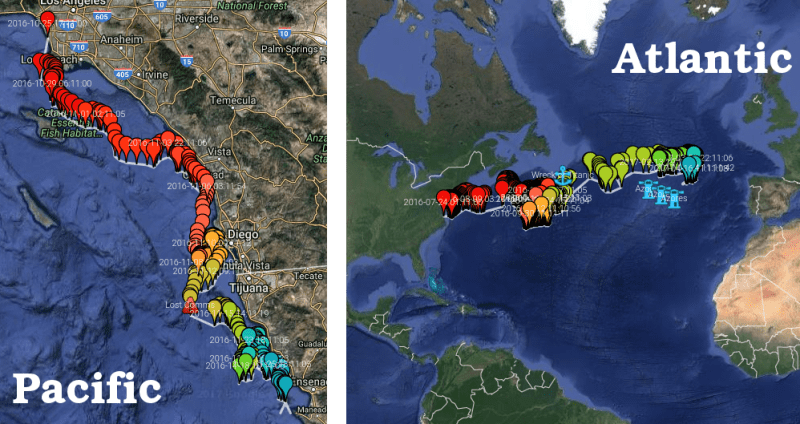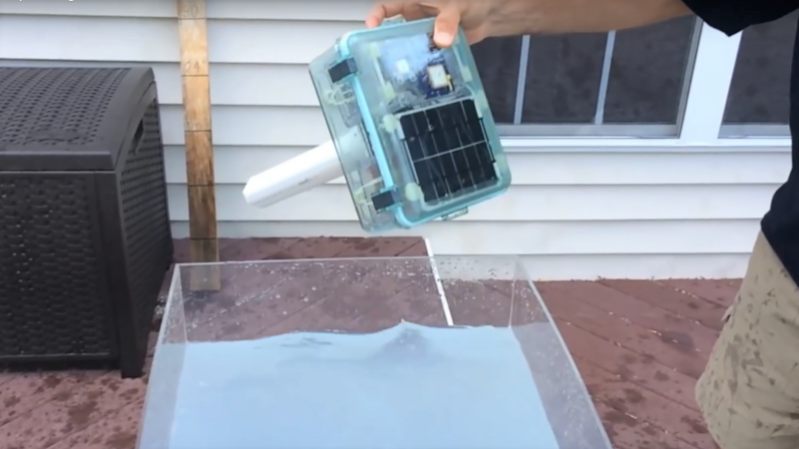Put a message in a bottle and toss it in the ocean, and if you’re very lucky, years later you might get a response. Drop a floating Arduino-fied buoy into the ocean and if you’ve engineered it well, it may send data back to you for even longer.

At least that’s what [Wayne] has learned since his MDBuoyProject went live with the launching of a DIY drift buoy last year. The BOM for the buoy reads like a page from the Adafruit website: Arduino Trinket, an RTC, GPS module, Iridium satellite modem, sensors, and a solar panel. Everything lives in a clear plastic dry box along with a can of desiccant and a LiPo battery.
The solar panel has a view through the case lid, and the buoy is kept upright by a long PVC boom on the bottom of the case. Two versions have been built and launched so far; alas, the Pacific buoy was lost shortly after it was launched. But the Atlantic buoy picked up the Gulf Stream and has been drifting slowly toward Europe since last summer, sending back telemetry. A future version aims to incorporate an Automatic Identification System (AIS) receiver, presumably to report the signals of AIS transponders on nearby ships as they pass.
We like the attention to detail as well as the low cost of this build. It’s a project that’s well within reach of a STEM program, akin to the many high-altitude DIY balloon projects we’ve featured before.
Thanks to [Adrian] for the tip.















Meh.
TFA is one of those pages which turn up blank when Javascript is disabled. From time to time I actually look into such a page’s source… and I’m happy each time that I *do* disable Javascript.
Lots of other interesting things on the Internet. Wayne, you’ll have to make do without my eyeballs.
tomas: No one cares.
That’s incorrect. Pages like these make me cringe. I don’t mind JS if it provides value but a page where the content is solely created at runtime using JS? No sir, that’s not how the web was intended to function, and Tomas rightfully complains about this.
A comparison to a modern game console: you put the game disc in the system and all it contains is a program to downloads the whole game from the Internet every time you want to play.
That’s how stupid those javascript-content-loading pages are.
Internet was designed to be used between universities to share data. It wasn’t designed for social networks and yet still people use it for that. It was not designed for JS generated web pages. Too bad because we are still going to do it. Like it or not :)
I want a browser addon that identifies grey text and alters it to black. Where do people get the idiot idea that grey text on a white background, or other low contrast color combinations, are the right thing to use?
[Galane]
Even worse, a website that uses white lettering on a black background!
B^)
[Ren] That’s actually easier to read for some people, especially dyslexics apparently.
Get over it. I’m a web developer and I can tell you that JavaScript will be around and even more prominent for the foreseeable future.
John,
this is just an underhanded way to say that I am “no one”. Perhaps *you* are the one who doesn’t exist?
(Fortunately there are people who care, besides myself).
Nope, really no one cares.
Many people enjoy pain, some flog themselves with barbed wire, others attempt to surf the internet with javascript completely disabled and proceed to bitch about it. No one cares, though at least the self flagellation is a bit more interesting.
Can confirm, no one cares. The days when you could harvest neckbeard appreciation points by disabling JS are thankfully over.
As I was going on the stair
I met a man that wasn’t there
He wasn’t there again today
Oh how I wish he’d go away.
Hi buddy, no-one here, you keep writing your js and I’ll keep blocking it. And I don’t care that I don’t see it, in fact I prefer it.
i care. excessive JS does not decide my whole interest in the project, but it sure is a hurdle. bad design is bad design and, being who we are, we often have a hard time ignoring it.
I think he might not really be at fault on this one seeing as this site was build with wix. It’s an online service that can get you a free web page and let you build it with a easy to use drag and drop interface. It was probably the easiest way for him to have a site without knowing how to do it.
Thanks SkinnyV. I started with Wix, but also own a regular site now (for Iridium message processing), so I have no excuse for not switching. It’s just an issue of time. I’ve chosen to instead work on the V3s with AIS collectors. Testing is considerable effort since I’m not directly near the shore. I think AIS will add some additional excitement to watching future buoys.
If you only need to test your AIS message handling, there are a number of online services that will give you global AIS feeds. You’ll probably need to filter a global feed, though, since that’s way more traffic than you’d see over the 38400 baud UART from the AIS receiver.
It works with scripting on but cookies blocked and all of the usual “bad” site inclusions blocked by Disconnect. You have to look at security from the point of view of risk levels vs layers of protection. That or build a time machine and go and live in 1995.
Did you recently stop whining about the fact that web pages are no longer a mile long and entirely center justified? Do you miss animated gifs as paragraph divisions and solid green background colours? Has the lack of marquee banners sucked your will to live?
You incredible snowflake!
Fascinating. Nice work at some considerable personal time and expense. You think that Pacific Buoy was smashed against the rocks of the cove it drifted into? Your drifting buoy simulates the path of any plastic bottle or flotsam in the ocean. Lets see where it will end up.
Yes, I assume it must have hit hard. V2 was more robust than V1, so it must have had a violent impact or literally went into a cave and hasn’t come out. I considered turning on Iridium every few months, just in case, but I’ve now moved on to V3s.
I like that the key to the survivability of the Atlantic version is that when the modem hangs, it runs out of juice and resets itself, then recharges when the sun comes out. Automating “turning it of and then on again” (like many WiFi installations) is pretty cool.
Also there is a track for a “spy buoy” in the blog – is that the new one?
It was built under the assumption that it would die occasionally, so considerable effort went into making sure it would recover gracefully from a dead battery. Key was to not pull a Ground Hog Day, i.e. forget it just sent some messages, send repeatedly, and bankrupt my Iridium account.
Yes, but I had to remove that data since it’s only for testing right now. Look for several V3 buoys with AIS receivers to go out sometime this summer. Thinking Gulf of Mexico and the Pacific (but further out this time).
It would be cool to fly a High Altitude Balloon off the coast and when it hits the water it is designed to become a buoy like this. Has anyone done this before?
This occurred to me when I was having problems finding a charter boat. I like the idea, especially if you could make the parachute out of something that would degrade in water or otherwise not contribute to ocean pollution. Buoy is bad enough, but I think we can agree it has a useful purpose in getting people interested in the ocean.
There’s a similar project that’s been floating around in the ocean just north of New Zealand for what will be a year in about three weeks http://www.qsl.net/zl1rs/oceanfloater.html no javascript required
Thanks for the link :)
Interesting project! Any idea of the legality?
I buy the argument that a buoy transmitting on a ham frequency is a type of propagation beacon and is allowed, but what happens when it drifts out of international waters and into a country that doesn’t have a reciprocal agreement with the licensee’s country?
Great project, very interesting. I wonder if the power budget would allow some sonar and sound recognition features too?
In summer at mid latitudes you have a decent power budget and could power a 75 mA @3.7V payload nearly continuously. This would drop quickly as winter approached. AIS in V3 uses 35 mA and I plan to be conservative and experiment with turning it on for 30 min at a time every hr, reporting every few hrs both normal update and any AIS messages. Buoy has two-way Iridium SBD, so on-time and reporting interval are modifiable.
Do you have telemetry data of battery/charging rates? Would be interested in a datadump to analyze it, for evaluating a similar project in the mediterranean.
Great project!
Unfortunately V1/2 did not have voltage or charge level. V3s will report LiPo Voltage through a voltage divider connected to an analog pin. I was unsuccessful getting Sparkfun’s LiPo fuel gauge to work with the solar charger. If you let me know your specific question, I may be able to collect some data from the V3s before sending them off. Contact me via the link on the WIX site.
The image “Internal Hardware” on the website shows that there is one watertight outer case and three watertight internal cases (connected with cables via IP68 cable glands). What is the rationale behind that design? Wouldn’t it be sufficient to have just one watertight outer case?
Great question. I knew someone would eventually ask. Simple answer is robustness. It was $500 of equipment I was throwing into the ocean and I really wanted it to last. Unfortunately, without a moisture sensor inside, I don’t know how watertight the outer case is after 280 days. That’s a lot of solar cycles and thrashing about. It may be way overkill, but it was a small investment of about $35 for the three interior cases and gland fittings for some peace of mind.